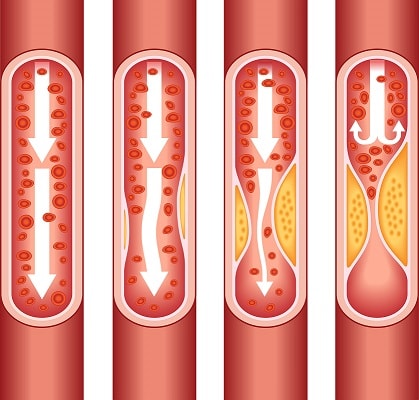The term “heart disease” refers to several types of heart conditions. The most common type of heart disease in the United States is coronary artery disease, which affects the blood flow to the heart. Decreased blood flow can cause a heart attack. This post will attempt to provide useful and relevant information about this deadly disease.
The 10 leading causes of death of African Americans1 in 2016 from the CDC are:
- Diseases of heart
- Malignant neoplasms (Cancer)
- Cerebrovascular diseases
- Accidents (unintentional
injuries) - Diabetes mellitus
- Chronic lower respiratory diseases
- Assault (homicide)
- Nephritis, nephrotic syndrome and
nephrosis - Alzheimer’s disease
- Septicemia
How are Arteries Blocked by Plaque

As plaque builds up in the arteries of a person with heart disease, the inside of the arteries begins to narrow, which lessens or blocks the flow of blood. Plaques can also rupture (break open) and when they do a blood clot can form on the plaque, blocking the flow of blood.
Heart Disease in the United States2
- About 610,000 people die of heart disease in the United States every year–that’s 1 in every 4 deaths.
- Heart disease is the leading cause of death for both men and women. More than half of the deaths due to heart disease in 2009 were in men.
- Coronary heart disease (CHD) is the most common type of heart disease, killing over 370,000 people annually.
- Every year about 735,000 Americans has a heart attack. Of these, 525,000 are a first heart attack and 210,000 happen in people who have already had a heart attack.
Key Definitions3
- Heart disease refers to several different types of heart conditions.
- Coronary artery disease is a type of heart disease that occurs when a substance called plaque builds up in the arteries that supply blood to the heart.
- Plaque is made up of cholesterol deposits, which can accumulate in your arteries.
- Atherosclerosis is a condition that occurs when too much plaque builds up in your arteries, causing them to narrow.
- Cholesterol is a fat-like substance in the body. High levels in the blood can lead to heart disease and stroke.
- Diabetes is a disease that affects the body’s use of insulin. Insulin tells the body to remove sugar from the blood. People with diabetes either don’t make enough insulin, can’t use their own insulin as well as they should, or both.
- Obesity is excess body fat.
Heart Disease Deaths Vary by Race and Ethnicity
Heart disease is the leading cause of death for people of most ethnicities in the United States, including African Americans, Hispanics, and whites. For American Indians or Alaska Natives and Asians or Pacific Islanders, heart disease is second only to cancer. Below are the percentages of all deaths caused by heart disease in 2008, listed by ethnicity.
| Race or Ethnic Group | % of Deaths |
|---|---|
| American Indians or Alaska Natives | 18.4 |
| Asians or Pacific Islanders | 22.2 |
| Non-Hispanic Blacks | 23.8 |
| Non-Hispanic Whites | 23.8 |
| All | 23.5 |
Early Action is Important for Heart Attack

Know the warning signs and symptoms of a heart attack so that you can act fast if you or someone you know might be having a heart attack. The chances of survival are greater when emergency treatment begins quickly.
- In a 2005 survey, most respondents—92%—recognized chest pain as a symptom of a heart attack. Only 27% were aware of all major symptoms and knew to call 9-1-1 when someone was having a heart attack.
- About 47% of sudden cardiac deaths occur outside a hospital. This suggests that many people with heart disease don’t act on early warning signs.
Heart attacks have several major warning signs and symptoms:
- Chest pain or discomfort.
- Upper body pain or discomfort in the arms, back, neck, jaw, or upper stomach.
- Shortness of breath.
- Nausea, lightheadedness, or cold sweats.
Americans at Risk for Heart Disease
High blood pressure, high cholesterol, and smoking are key risk factors for heart disease. About half of Americans (47%) have at least one of these three risk factors.
Several other medical conditions and lifestyle choices can also put people at a higher risk for heart disease, including:
- Diabetes
- Overweight and obesity
- Poor diet
- Physical inactivity
- Excessive alcohol use
Preventing Heart Disease: Healthy Living Habits4
By living a healthy lifestyle, you can help keep your blood pressure, cholesterol, and sugar normal and lower your risk for heart disease and heart attack. A healthy lifestyle includes the following:
- Eating a healthy diet.
- Maintaining a healthy weight.
- Getting enough physical activity.

- Not smoking or using other forms of tobacco.
- Limiting alcohol use.
Healthy Diet
Choosing healthful meal and snack options can help you avoid heart disease and its complications. Be sure to eat plenty of fresh fruits and vegetables and fewer processed foods.
Eating foods low in saturated fats, trans fat, and cholesterol and high in fiber can help prevent high cholesterol. Limiting salt (sodium) in your diet also can lower your blood pressure. Limiting sugar in your diet can lower your blood sugar level to prevent or help control diabetes.
For more information on healthy diet and nutrition, see CDC’s Nutrition, Physical Activity, and Obesity Program website.
Healthy Weight
Being overweight or obese increases your risk for heart disease. To determine if your weight is in a healthy range, doctors often calculate your body mass index (BMI). If you know your weight and height, you can calculate your BMI at CDC’s Assessing Your Weight website. Doctors sometimes also use waist and hip measurements to calculate excess body fat. They may use special equipment to calculate excess body fat and hydration status.
Physical Activity
Physical activity can help you maintain a healthy weight and lower your blood pressure, cholesterol, and sugar levels. For adults, the Surgeon General recommends 2 hours and 30 minutes of moderate-intensity exercise, like brisk walking or bicycling, every week. Children and adolescents should get 1 hour of physical activity every day.

For more information, see CDC’s Nutrition, Physical Activity, and Obesity Web site.
No Smoking
Cigarette smoking greatly increases your risk for heart disease. If you don’t smoke, don’t start. If you do smoke, quitting will lower your risk for heart disease. Your doctor can suggest ways to help you quit.
For more information about tobacco use and quitting, see CDC’s Smoking & Tobacco Use Web site.
Limited Alcohol
Avoid drinking too much alcohol, which can raise your blood pressure. Men should have no more than 2 drinks per day, and women only 1. For more information, visit CDC’s Alcohol and Public Health Website.
Preventing Heart Disease: Other Medical Conditions
If you have high cholesterol, high blood pressure, or diabetes, you can take steps to lower your risk for heart disease.
Check Cholesterol
Your health care provider should test your blood levels of cholesterol at least once every 5 years. If you have already been diagnosed with high cholesterol or have a family history of the condition, you may have your cholesterol checked more frequently. Talk with your health care team about this simple blood test. If you have high cholesterol, medications and lifestyle changes can help reduce your risk for heart disease.
Control Blood Pressure
High blood pressure usually has no symptoms, so be sure to have it checked on a regular basis. Your health care team should measure your blood pressure at least once every 2 years if you have never had high blood pressure or other risk factors for heart disease. If you have been diagnosed with high blood pressure, also called hypertension, your health care team will measure your blood pressure more frequently to ensure you have the condition under control. Talk to your health care team about how often you should check your blood pressure. You can check it at a doctor’s office, at a pharmacy, or at home.
If you have high blood pressure, your health care team might recommend some changes in your lifestyle or advise you to lower the sodium in your diet; your doctor may also prescribe medication when necessary to help lower your blood pressure. There are many strategies to help monitor and improve blood pressure control and medication adherence Cdc-pdf[PDF-1M]External to improve health outcomes for patients with hypertension.

Manage Diabetes
If your health care provider thinks you have symptoms of diabetes, he or she may recommend that you get tested. If you have diabetes, monitor your blood sugar levels carefully. Talk with your health care team about treatment options. Your doctor may recommend certain lifestyle changes to help keep your blood sugar under good control—those actions will help reduce your risk for heart disease.
Take Your Medicine
If you take medication to treat high cholesterol, high blood pressure, or diabetes, follow your doctor’s instructions carefully. Always ask questions if you don’t understand something. Never stop taking your medication without talking to your doctor, nurse, or pharmacist.
Talk with Your Health Care Team
You and your health care team can work together to prevent or treat the medical conditions that lead to heart disease. Discuss your treatment plan regularly, and bring a list of questions to your appointments.
If you’ve already had a heart attack, your health care team will work with you to prevent another heart attack. Your treatment plan may include medications or surgery and lifestyle changes to reduce your risk. Be sure to take your medications as directed and follow your doctor’s instructions.
CDC Fact Sheets Related to Heart Disease
- Heart Disease Fact Sheet
- Men and Heart Disease
- Women and Heart Disease
- Atrial Fibrillation
- Cardiomyopathy
- Heart Failure
- Signs and Symptoms of a Heart Attack
- Aortic Aneurysm
- Cholesterol
- High Blood Pressure
- Pulmonary Hypertension Fact Sheet
Jay Harold provides relevant and practical knowledge for your life, your health, and your wealth. ”This post, “5 Heart Disease Risk Factors: Prevention & More” is part of that effort to make you a more knowledgeable financial person. Please Share it and read more about Jay Harold here. Please take this advice from Muhammad Ali and give back to others. “Service to others is the rent you pay for your room here on earth.




